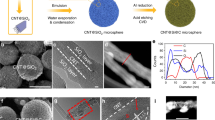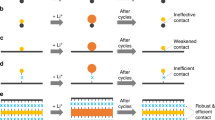Abstract
Increasing the energy storage capability of lithium-ion batteries necessitates maximization of their areal capacity. This requires thick electrodes performing at near-theoretical specific capacity. However, achievable electrode thicknesses are restricted by mechanical instabilities, with high-thickness performance limited by the attainable electrode conductivity. Here we show that forming a segregated network composite of carbon nanotubes with a range of lithium storage materials (for example, silicon, graphite and metal oxide particles) suppresses mechanical instabilities by toughening the composite, allowing the fabrication of high-performance electrodes with thicknesses of up to 800 μm. Such composite electrodes display conductivities up to 1 × 104 S m−1 and low charge-transfer resistances, allowing fast charge-delivery and enabling near-theoretical specific capacities, even for thick electrodes. The combination of high thickness and specific capacity leads to areal capacities of up to 45 and 30 mAh cm−2 for anodes and cathodes, respectively. Combining optimized composite anodes and cathodes yields full cells with state-of-the-art areal capacities (29 mAh cm−2) and specific/volumetric energies (480 Wh kg−1 and 1,600 Wh l−1).
This is a preview of subscription content, access via your institution
Access options
Access Nature and 54 other Nature Portfolio journals
Get Nature+, our best-value online-access subscription
$29.99 / 30 days
cancel any time
Subscribe to this journal
Receive 12 digital issues and online access to articles
$119.00 per year
only $9.92 per issue
Buy this article
- Purchase on Springer Link
- Instant access to full article PDF
Prices may be subject to local taxes which are calculated during checkout





Similar content being viewed by others
Data availability
The datasets generated during and/or analysed during the current study are available from the corresponding author on reasonable request.
References
Dunn, B., Kamath, H. & Tarascon, J. M. Electrical energy storage for the grid: a battery of choices. Science 334, 928–935 (2011).
Chiu, R. C., Garino, T. J. & Cima, M. J. Drying of granular ceramic films. 1. Effect of processing variables on cracking behavior. J. Am. Ceram. Soc. 76, 2257–2264 (1993).
Singh, K. B. & Tirumkudulu, M. S. Cracking in drying colloidal films. Phys. Rev. Lett. 98, 218302 (2007).
Danner, T. et al. Thick electrodes for Li-ion batteries: a model based analysis. J. Power Sources 334, 191–201 (2016).
Wang, G. P., Zhang, Q. T., Yu, Z. L. & Qu, M. Z. The effect of different kinds of nano-carbon conductive additives in lithium ion batteries on the resistance and electrochemical behavior of the LiCoO2 composite cathodes. Solid State Ion. 179, 263–268 (2008).
Tian, R. et al. Quantifying the factors limiting rate-performance in battery electrodes. Nat. Commun. 10, 1933 (2019).
Higgins, T. M. et al. A commercial conducting polymer as both binder and conductive additive for silicon nanoparticle-based lithium-ion battery negative electrodes. ACS Nano 10, 3702–3713 (2016).
Sander, J. S. et al. High-performance battery electrodes via magnetic templating. Nat. Energy 1, 16099 (2016).
Salvatierra, R. V. et al. Silicon nanowires and lithium cobalt oxide nanowires in graphene nanoribbon papers for full lithium ion battery. Adv. Energy Mater. 6, 1600918 (2016).
Peled, E. et al. Tissue-like silicon nanowires-based three-dimensional anodes for high-capacity lithium ion batteries. Nano Lett. 15, 3907–3916 (2015).
Leveau, L. et al. Silicon nano-trees as high areal capacity anodes for lithium-ion batteries. J. Power Sources 316, 1–7 (2016).
Yang, G. F., Song, K. Y. & Joo, S. K. Ultra-thick Li-ion battery electrodes using different cell size of metal foam current collectors. RSC Adv. 5, 16702–16706 (2015).
Wang, J. S. et al. Formulation and characterization of ultra-thick electrodes for high energy lithium-ion batteries employing tailored metal foams. J. Power Sources 196, 8714–8718 (2011).
Hu, L. B. et al. Lithium-ion textile batteries with large areal mass loading. Adv. Energy Mater. 1, 1012–1017 (2011).
Elango, R., Demortiere, A., De Andrade, V., Morcrette, M. & Seznec, V. Thick binder-free electrodes for Li-ion battery fabricated using templating approach and spark plasma sintering reveals high areal capacity. Adv. Energy Mater. 8, 1703031 (2018).
Choi, M. J. et al. Novel strategy to improve the Li-storage performance of micro silicon anodes. J. Power Sources 348, 302–310 (2017).
Zhang, C. F. et al. Enabling flexible heterostructures for li-ion battery anodes based on nanotube and liquid-phase exfoliated 2D gallium chalcogenide nanosheet colloidal solutions. Small 13, 1701677 (2017).
Liu, Y. P. et al. Electrical, mechanical and capacity percolation leads to high-performance MoS2/nanotube composite lithium ion battery electrodes. ACS Nano 10, 5980–5990 (2016).
Jurewicz, I. et al. Locking carbon nanotubes in confined lattice geometries—a route to low percolation in conducting composites. J. Phys. Chem. B 115, 6395–6400 (2011).
Sundaram, R. M. & Windle, A. H. One-step purification of direct-spun CNT fibers by post-production sonication. Mater. Des. 126, 85–90 (2017).
Gabbett, C. et al. The effect of network formation on the mechanical properties of 1D:2D nano:nano composites. Chem. Mater. 30, 5245–5255 (2018).
Ge, H. C. & Wang, J. C. Ear-like poly (acrylic acid)-activated carbon nanocomposite: a highly efficient adsorbent for removal of Cd(ii) from aqueous solutions. Chemosphere 169, 443–449 (2017).
Wang, W. et al. Silicon decorated cone shaped carbon nanotube clusters for lithium ion battery anodes. Small 10, 3389–3396 (2014).
Zhang, L. et al. A coordinatively cross-linked polymeric network as a functional binder for high-performance silicon submicro-particle anodes in lithium-ion batteries. J. Mater. Chem. C 2, 19036–19045 (2014).
Assresahegn, B. D. & Belanger, D. Effects of the formulations of silicon-based composite anodes on their mechanical, storage and electrochemical properties. ChemSusChem 10, 4080–4089 (2017).
Li, X. L. et al. Mesoporous silicon sponge as an anti-pulverization structure for high-performance lithium-ion battery anodes. Nat. Commun. 5, 4105 (2014).
Yan, L. J. et al. In situ wrapping Si nanoparticles with 2D carbon nanosheets as high-areal-capacity anode for lithium-ion batteries. ACS Appl. Mater. Interfaces 9, 38159–38164 (2017).
Krause, A. et al. High area capacity lithium-sulfur full-cell battery with prelitiathed silicon nanowire-carbon anodes for long cycling stability. Sci. Rep. 6, 27982 (2016).
Li, B., Li, S. M., Xu, J. J. & Yang, S. B. A new configured lithiated silicon–sulfur battery built on 3D graphene with superior electrochemical performances. Energy Environ. Sci. 9, 2025–2030 (2016).
Shi, F. F. et al. Failure mechanisms of single-crystal silicon electrodes in lithium-ion batteries. Nat. Commun. 7, 11886 (2016).
Nguyen, C. C. & Lucht, B. L. Development of electrolytes for Si–graphite composite electrodes. J. Electrochem. Soc. 165, A2154–A2161 (2018).
Singh, M., Kaiser, J. & Hahn, H. Thick electrodes for high energy lithium ion batteries. J. Electrochem. Soc. 162, A1196–A1201 (2015).
Singh, M., Kaiser, J. & Hahn, H. A systematic study of thick electrodes for high energy lithium ion batteries. J. Electroanal. Chem. 782, 245–249 (2016).
Gallagher, K. G. et al. Optimizing areal capacities through understanding the limitations of lithium-ion electrodes. J. Electrochem. Soc. 163, A138–A149 (2016).
Purvins, A., Papaioannou, I. T. & Debarberis, L. Application of battery-based storage systems in household-demand smoothening in electricity-distribution grids. Energy Convers. Manag. 65, 272–284 (2013).
Yamada, M. et al. Performance of the ‘SiO’-carbon composite-negative electrodes for high-capacity lithium-ion batteries; prototype 14500 batteries. J. Power Sources 225, 221–225 (2013).
Son, I. H. et al. Silicon carbide-free graphene growth on silicon for lithium-ion battery with high volumetric energy density. Nat. Commun. 6, 7393 (2015).
Ma, L. et al. A guide to ethylene carbonate-free electrolyte making for Li-ion cells. J. Electrochem. Soc. 164, A5008–A5018 (2017).
Acknowledgements
All authors acknowledge the SFI-funded AMBER research centre (SFI/12/RC/2278) and the Advanced Microscopy Laboratory for the provision of facilities and thank R. Charifou, who performed XRD for the samples. J.N.C. thanks Science Foundation Ireland (SFI, 11/PI/1087), the European Research Council (AdvGr FUTUREPRINT) and the Graphene Flagship (grant agreement no. 785219) for funding. V.N. thanks the European Research Council (SoG 3D2D Print) and Science Foundation Ireland (PIYRA) for funding.
Author information
Authors and Affiliations
Contributions
S.-H.P., P.J.K., J.N.C. and V.N. conceived the project. S.-H.P. and P.J.K. designed materials and experiments. S.-H.P. and P.J.K. fabricated composite electrodes. S.-H.P. performed electrochemical characterization. N.M. performed Raman analysis. S.-H.P., P.J.K., J.C. and R.T. analysed electrochemical data. J.C. and D.D. performed electron microscopic analysis. S.-H.P. and J.C.-F.Z. measured electrical conductivity. C.S.B. and P.M. performed mechanical measurement. S.-H.P. and J.N.C. wrote the manuscript. All authors discussed the results and commented on the manuscript.
Corresponding authors
Ethics declarations
Competing interests
The authors declare no competing interests.
Additional information
Publisher’s note: Springer Nature remains neutral with regard to jurisdictional claims in published maps and institutional affiliations.
Supplementary information
Supplementary Information
Supplementary Figs. 1–28, Supplementary Tables 8, Supplementary Note 1, Supplementary references
Rights and permissions
About this article
Cite this article
Park, SH., King, P.J., Tian, R. et al. High areal capacity battery electrodes enabled by segregated nanotube networks. Nat Energy 4, 560–567 (2019). https://doi.org/10.1038/s41560-019-0398-y
Received:
Accepted:
Published:
Issue Date:
DOI: https://doi.org/10.1038/s41560-019-0398-y
This article is cited by
-
Quadruple the rate capability of high-energy batteries through a porous current collector design
Nature Energy (2024)
-
Standardized cycle life assessment of batteries using extremely lean electrolytic testing conditions
Communications Materials (2024)
-
Highly Efficient Aligned Ion-Conducting Network and Interface Chemistries for Depolarized All-Solid-State Lithium Metal Batteries
Nano-Micro Letters (2024)
-
High-Performance Thick Cathode Based on Polyhydroxyalkanoate Binder for Li Metal Batteries
Advanced Fiber Materials (2024)
-
Regulating electrostatic phenomena by cationic polymer binder for scalable high-areal-capacity Li battery electrodes
Nature Communications (2023)



